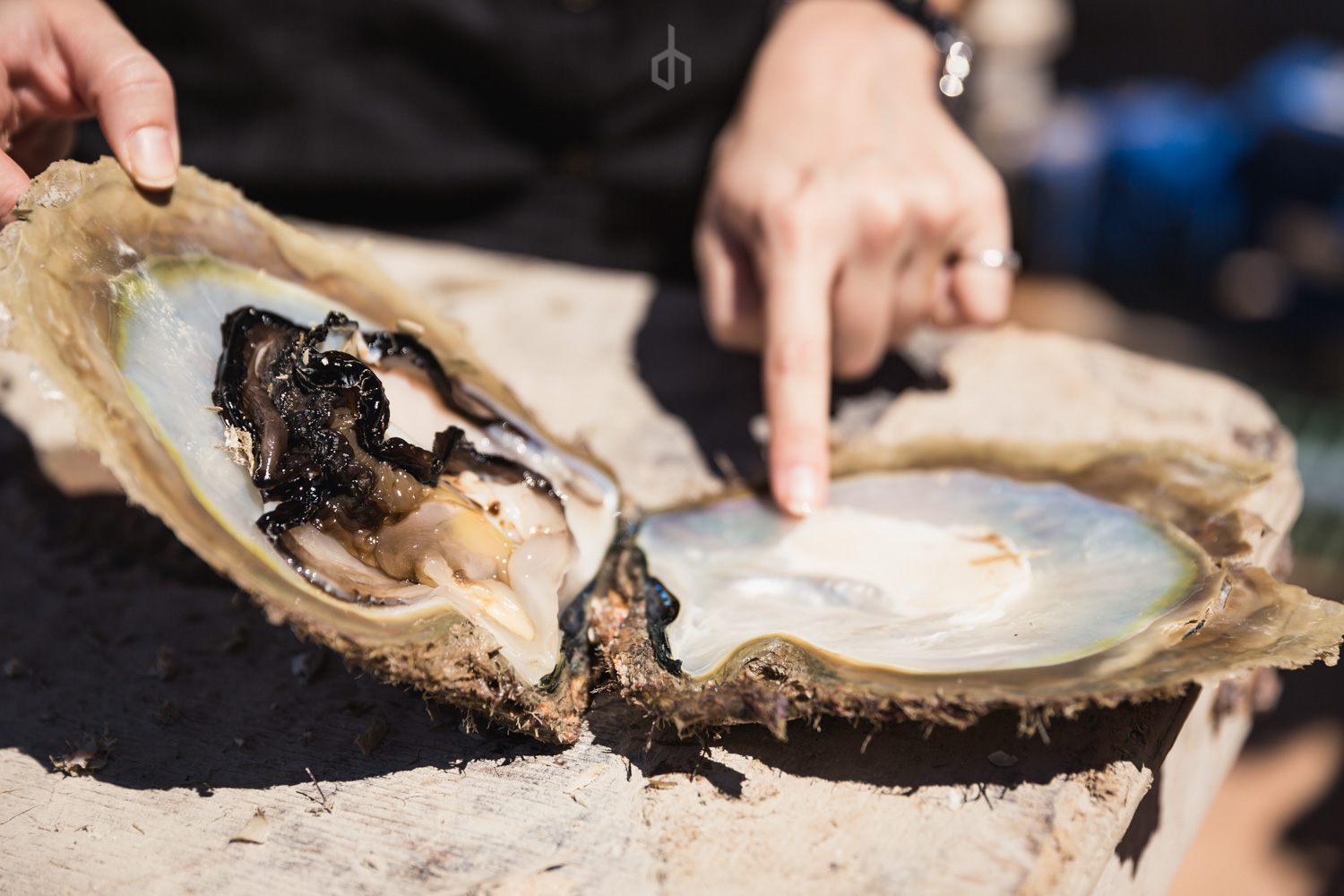
Another faacet of the pearl operation is the meat which sells for an exuberant price on international markets and in considered a delicacy worldwide. Here a lab worker is points to the small slab of white pearl meat.
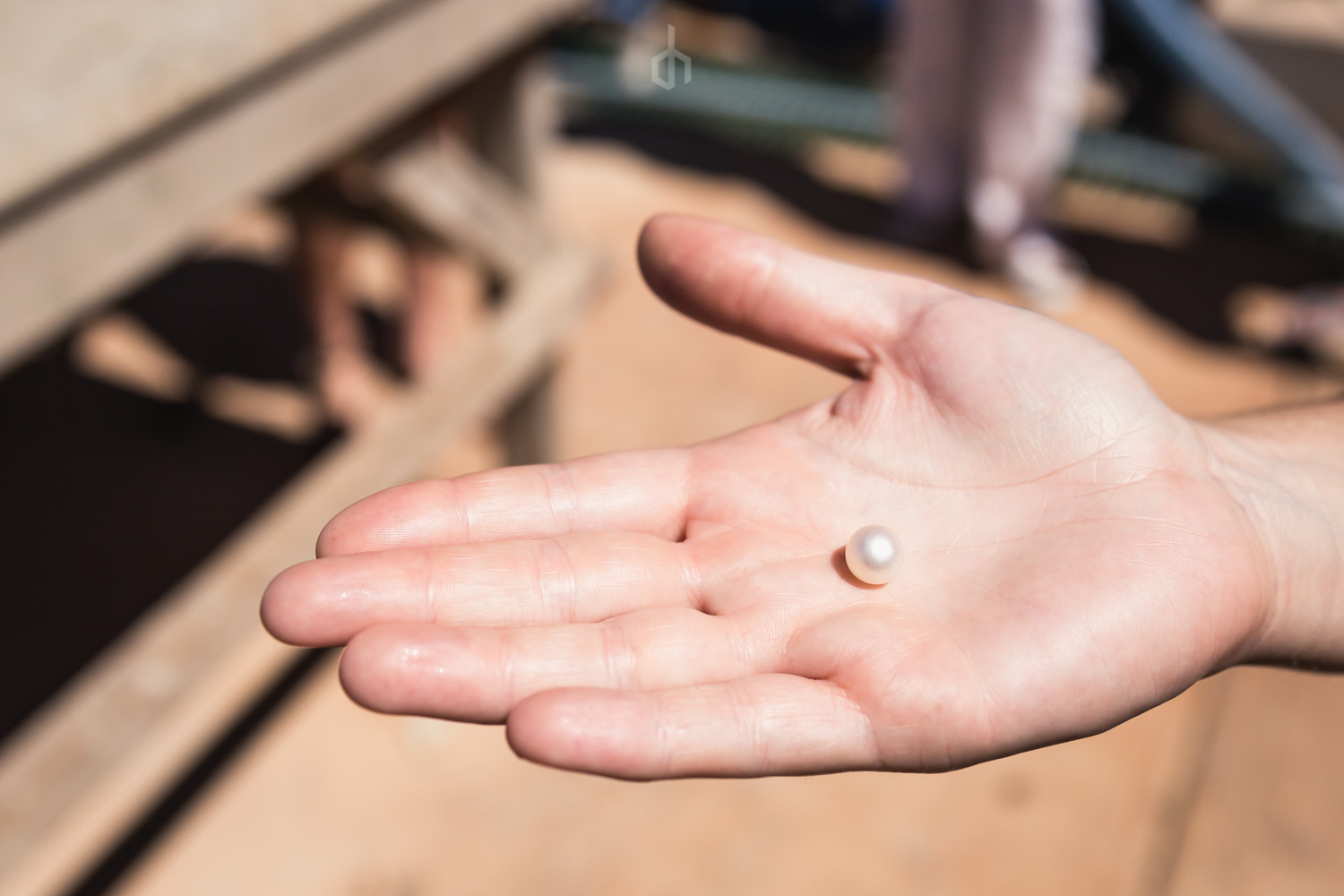
From Oyster to Pearl. The process of cultivating Pearls from Australian Pearl companies. Documented from time spent at sea on a working vessel and an active pearl farm.

The perks off working the dump boat. The divers often carry a spear gun incase they come across some fish suitable to feed the crew. Here is a massive Spanish Mackerel brought back for the chef to cook. Sashimi and Namus (or Civiche) are regular features on the menu.
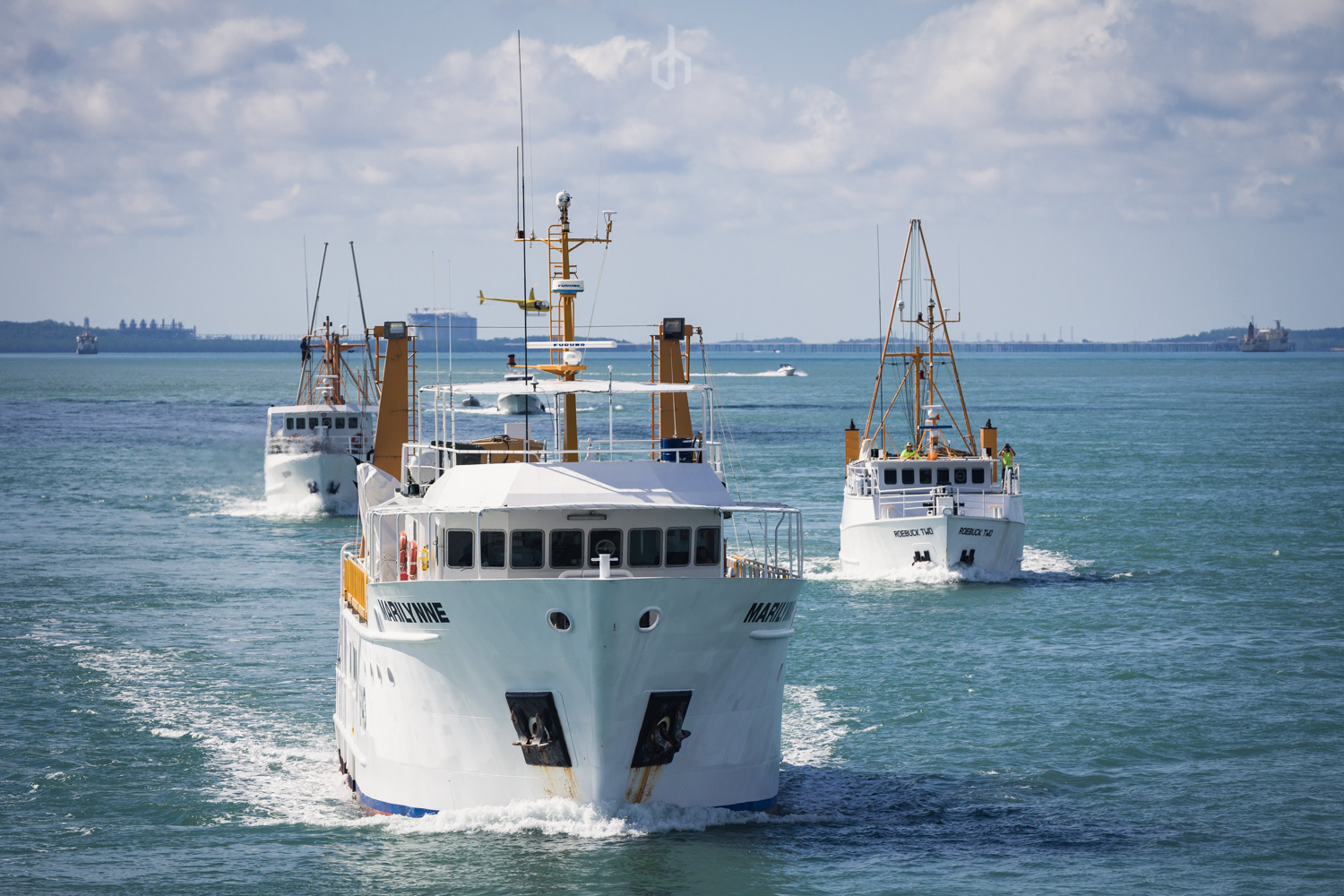
A trio of ships from Paspaleys Pearling fleet leaving Darwin to sail to Broome, WA, to begin the pearl diving season.
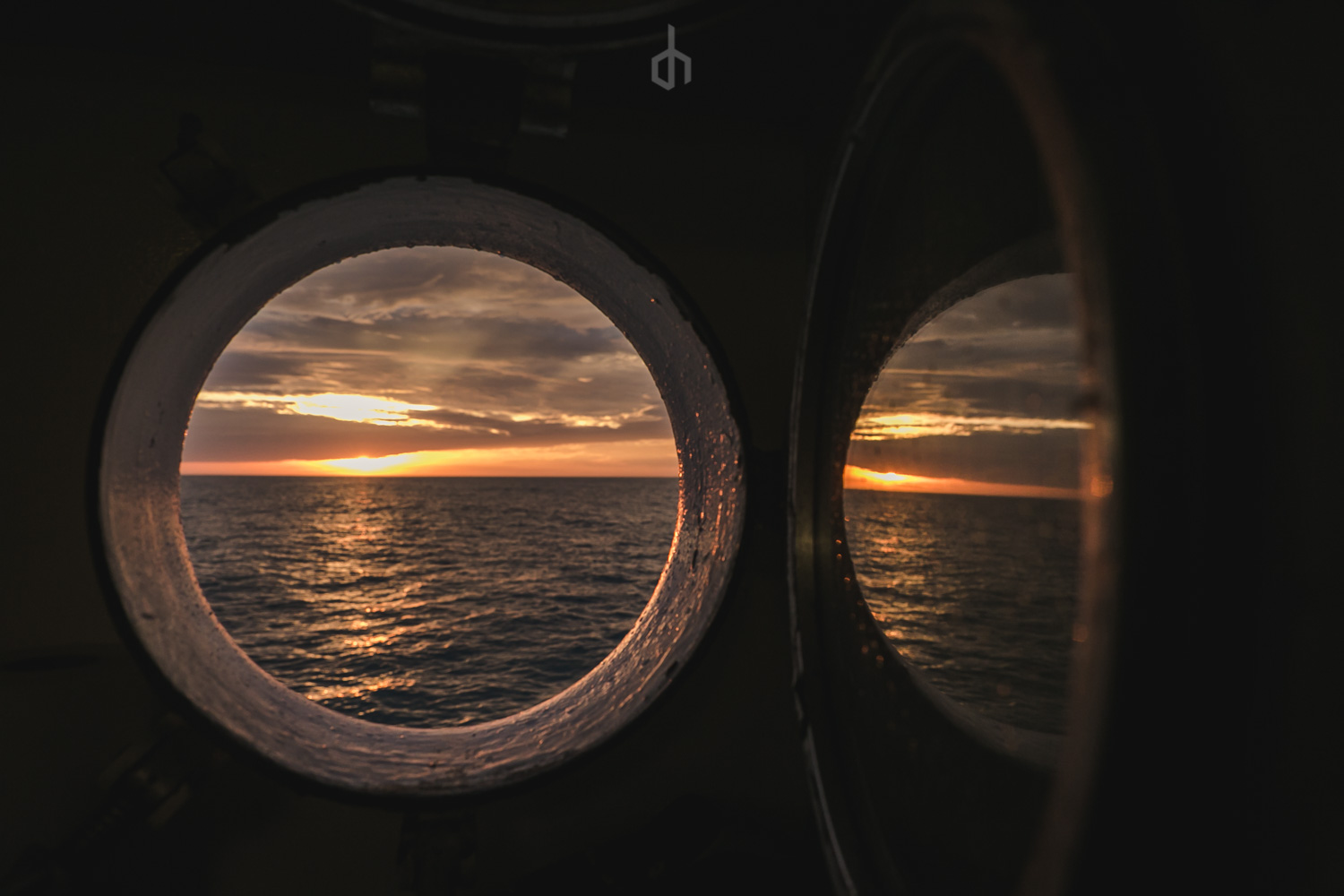
Looking out of the kitchen porthole on one of those stunning WA mornings.
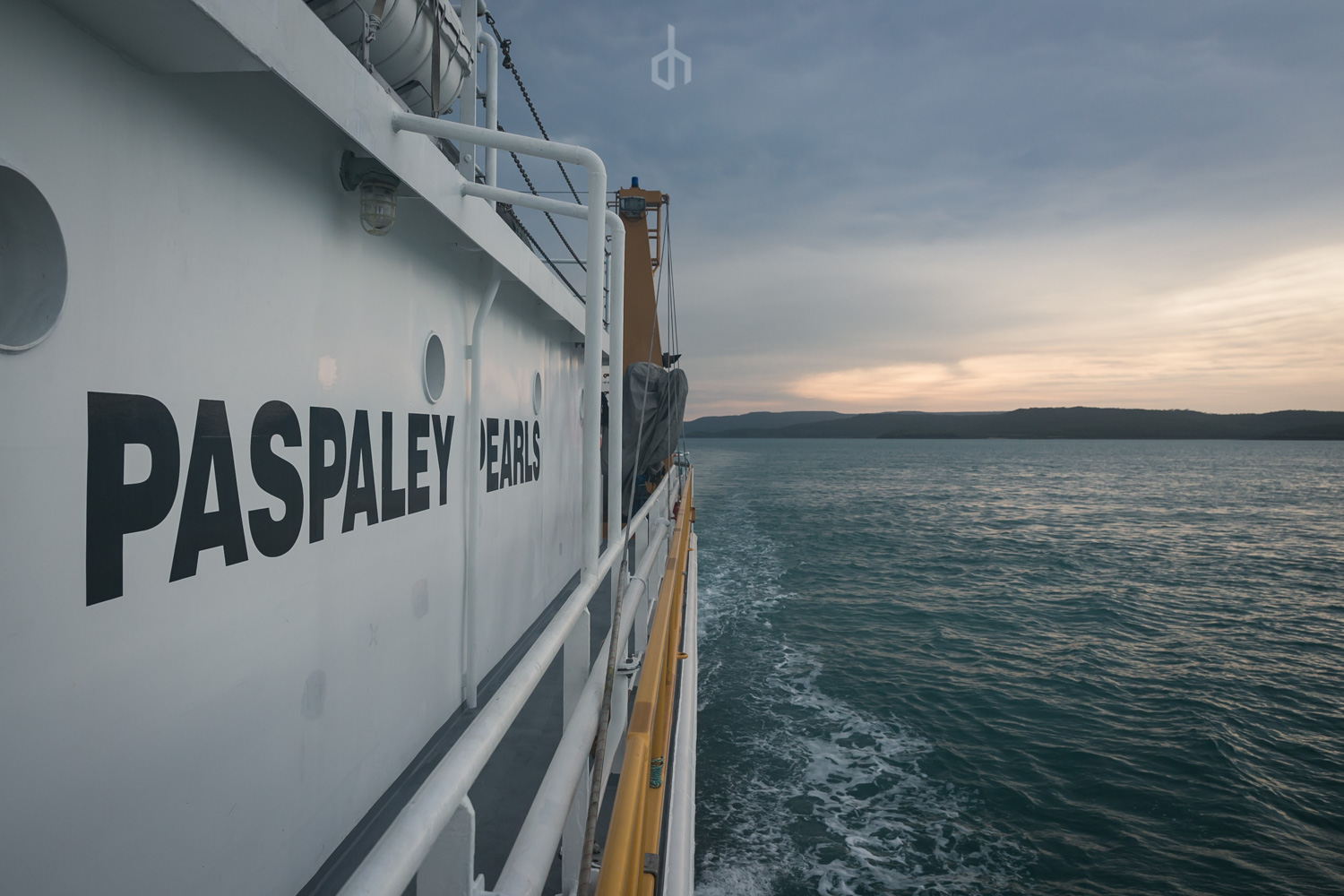
Steaming through the Buccaneers Archipelago down into the Kimberley, just a couple of weeks before the diving season is set to start.
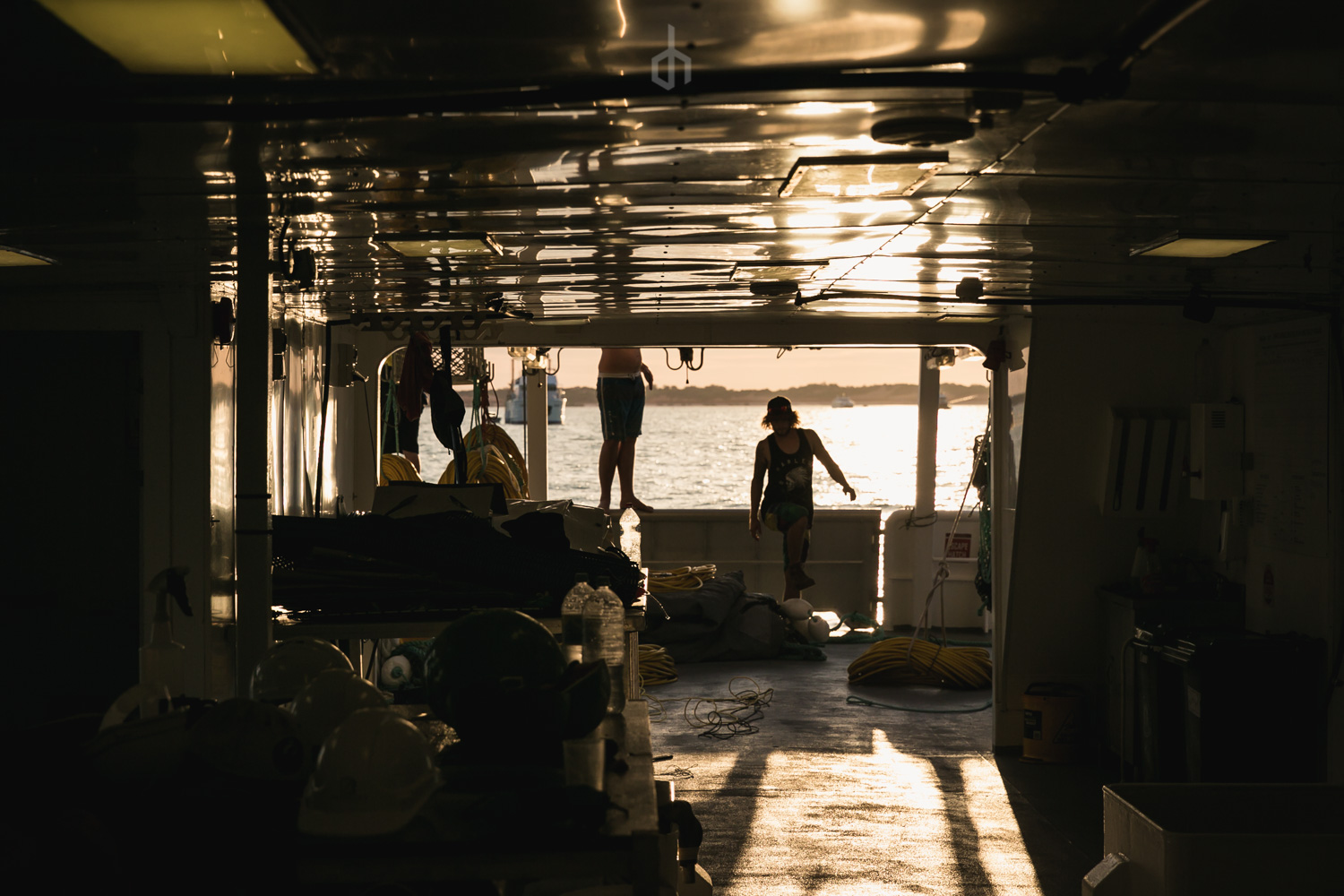
Pearl diving vessels in Broome sail on the Neap tides and are back in port for the Springs. Roebuck Bay during the Spring tide has many White ships sitting on storm moorings while the crews take R&R. Once the Spring is up the crews head back and the ships take turns on the dock to resupply before heading back out to sea.
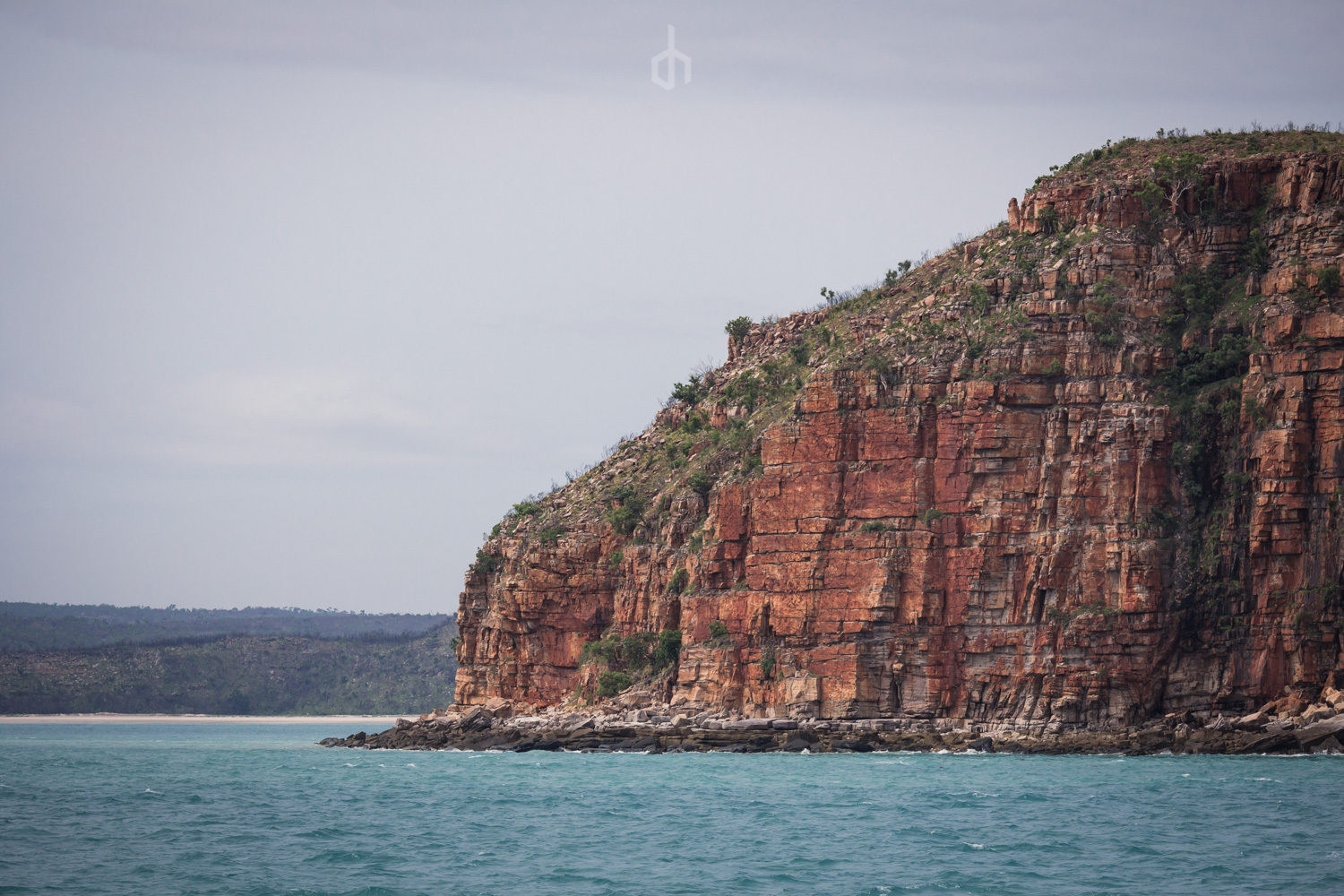
The red rocks and bright blue water of the east Kimberley coastline.
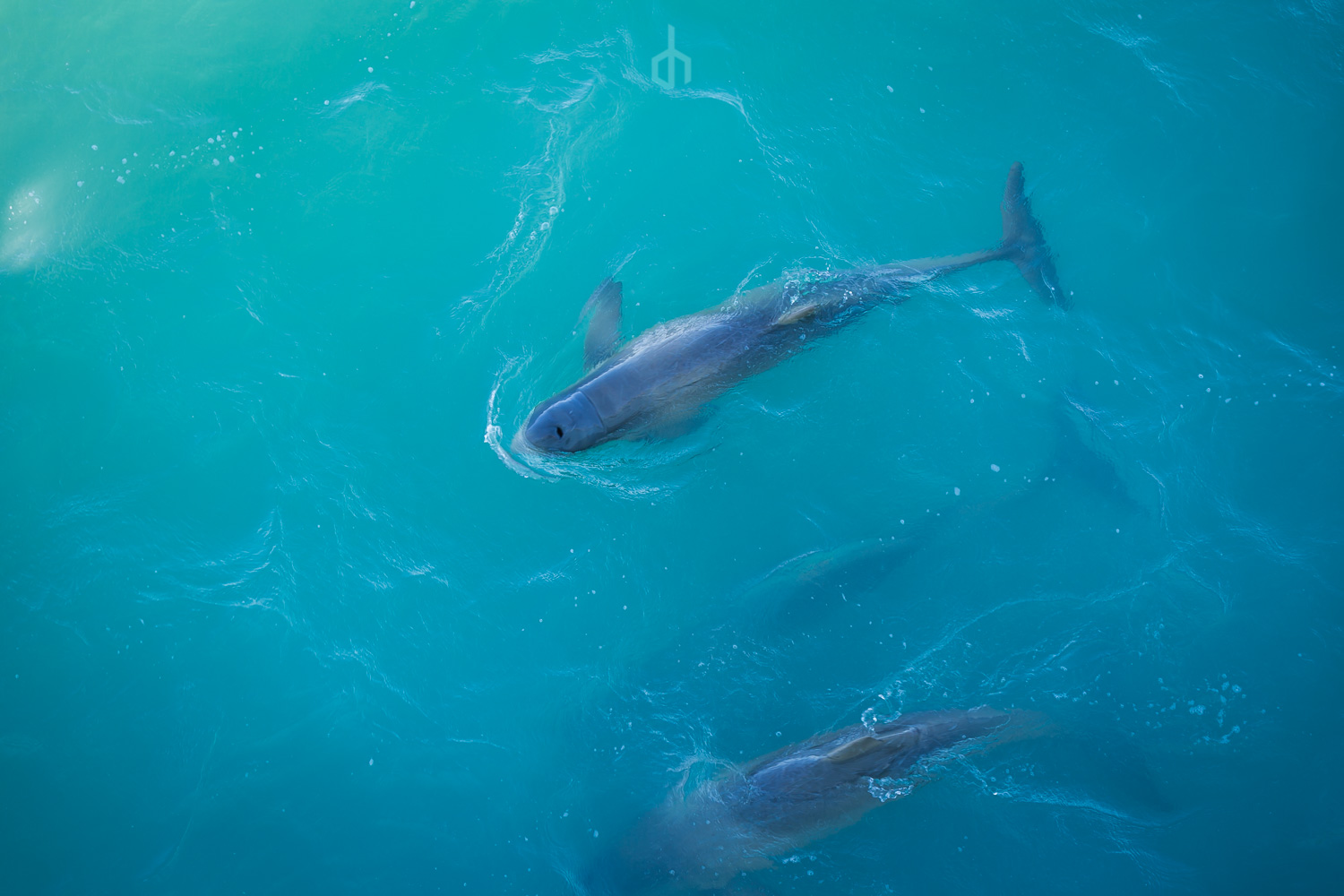
A rare species of dolphin native to Roebuck Bay would occasionally come and visit the ship.
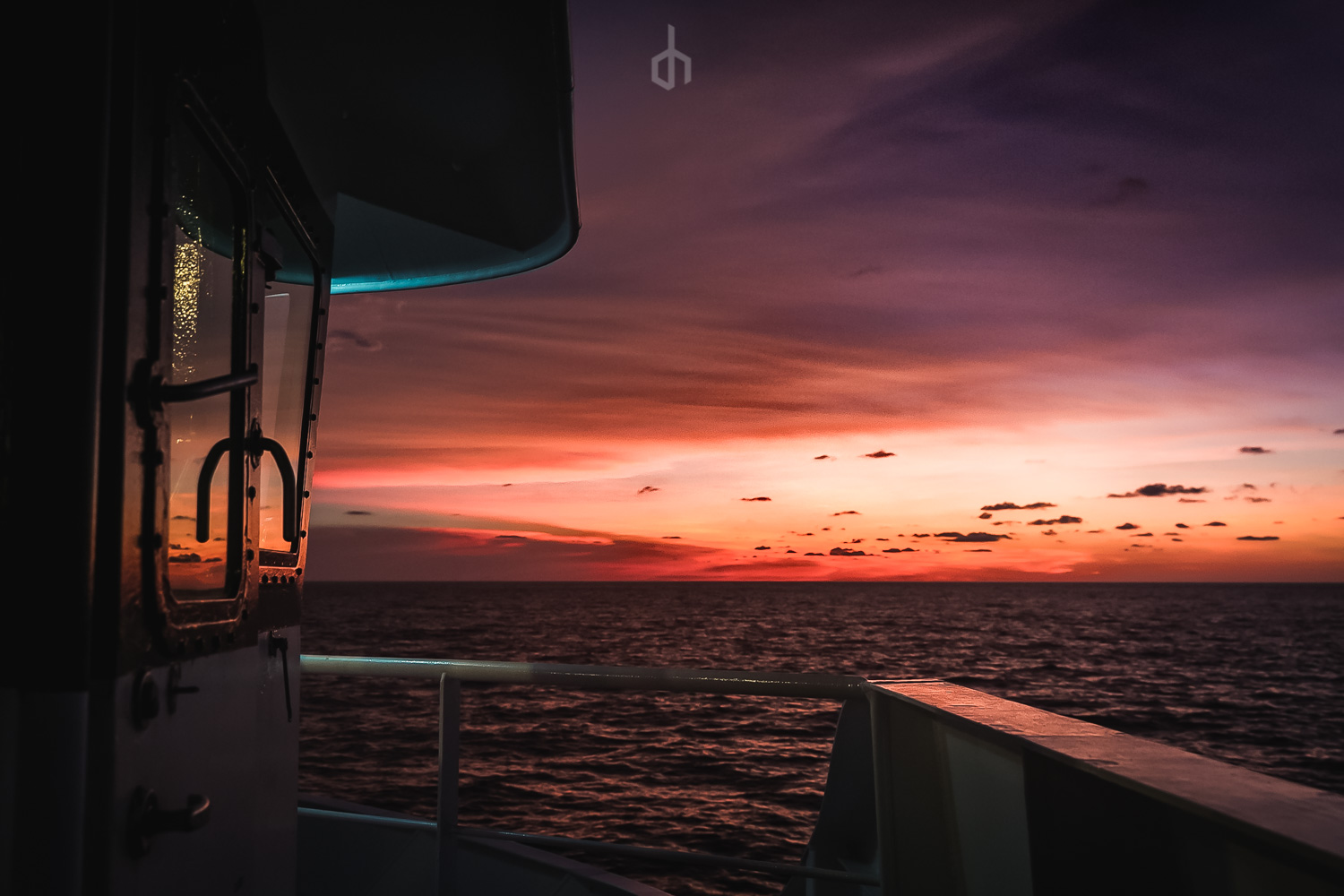
During the voyage from Darwin to Broome we were treated to amazing skies. Taken from the Bridge of the Nalena Bay.
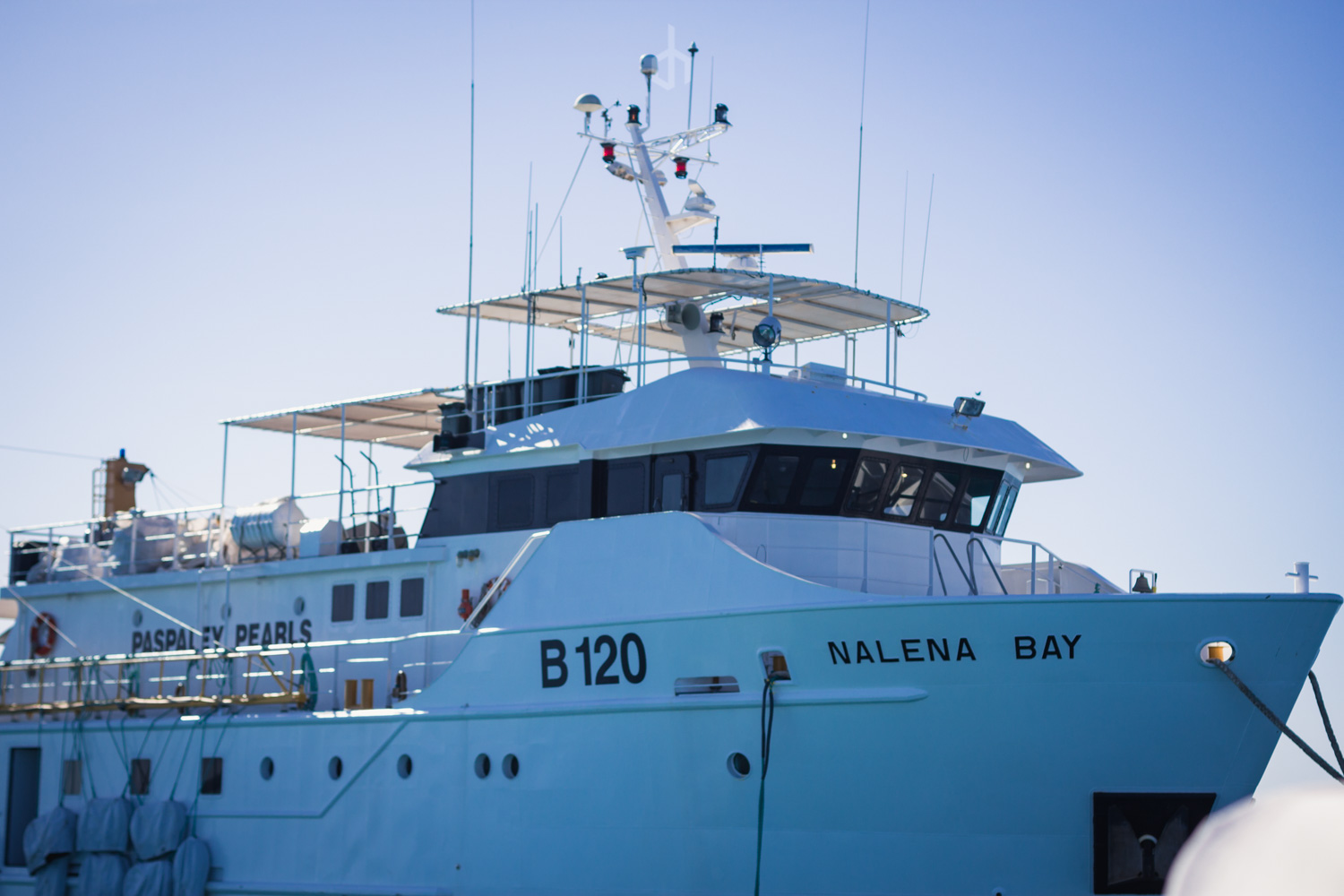
The Nalena Bay was at the time the newest edition to the Paspaley Pearls fleet. Inside she has three decks and 14 crew when set for drift diving. Her shape makes her comfortable even in the roughest seas, with little pitch she rolls easily over the waves.
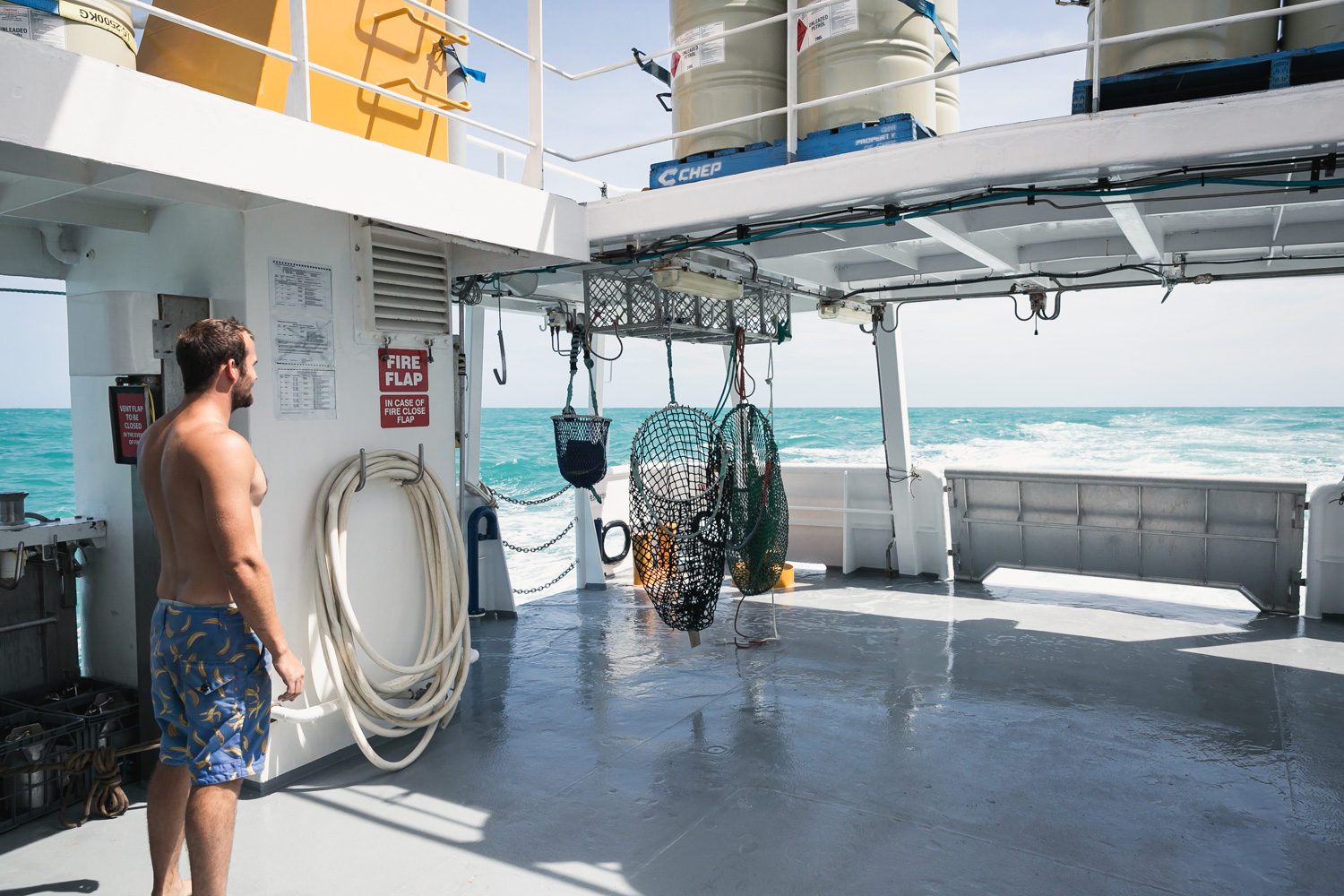
The weather in the Kimberley during the dry season is almost always sunny and calm. Time spent steaming to and from operating areas is enjoyed by the crew.

The rear off the ship is where all the work takes place. The divers hang their nets and gear from hooks ready to earn their bounty from the ocean floor. The divers carry a small net around their necks and large one attached to a line. They fill the small net skimming the ocean floor and as that fills up empty it into the large net. At the end of the dive the large nets are pulled to the surface by the deck hands who then turn them out to be sorted on the cleaning table.
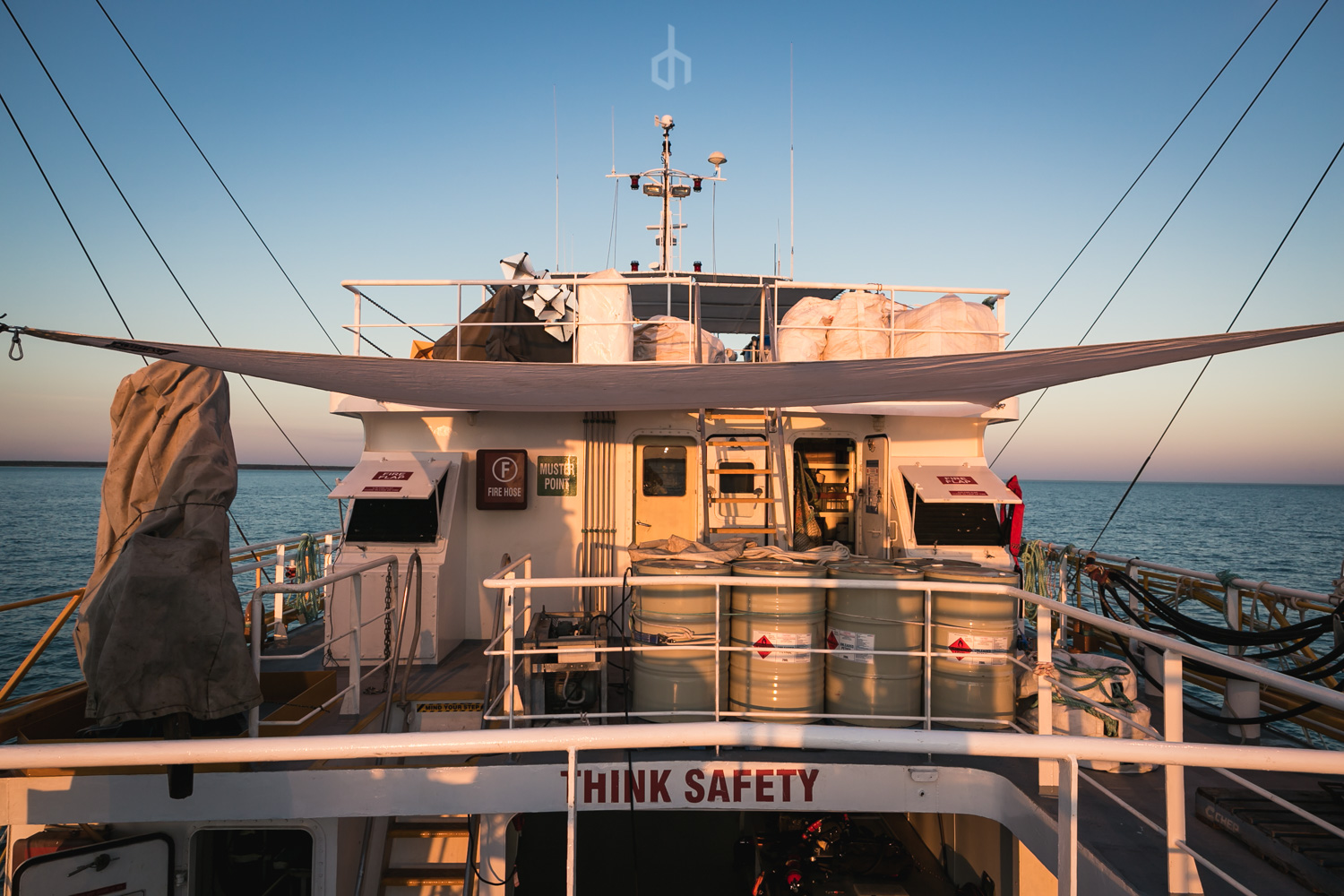
A ship is designated a certain patch of ocean where there is suspected to be a good level of shell on the floor which could be miles out to sea . Sometimes this requires steaming for a full day with the crew taking watch shifts to ensure the ship stays on course through the night.
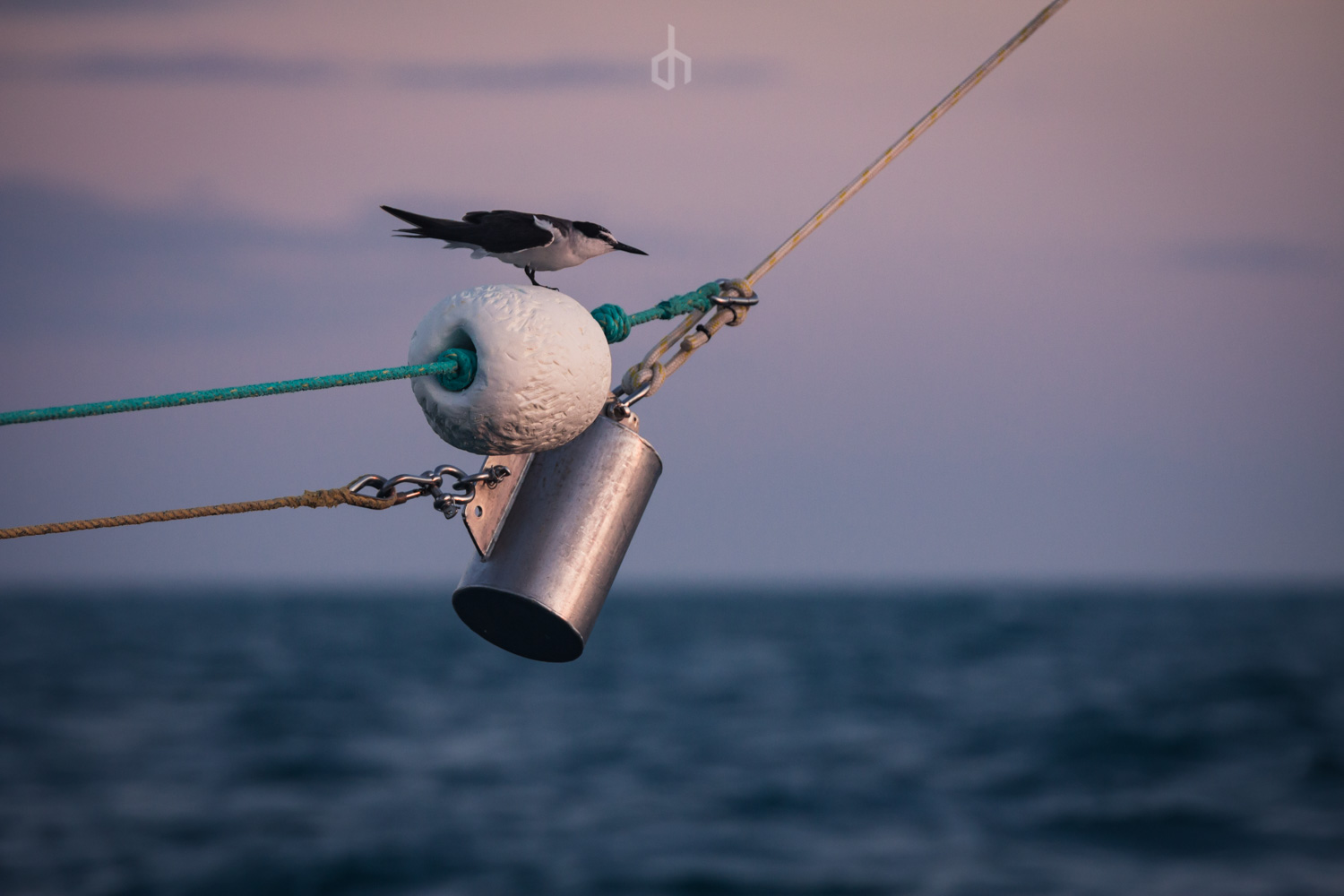
Regularly we would be miles out to sea with no land in sight and birds would land on the ship to hitch a ride. Often they would stick around for a day to rest before moving on. The crew takes a fondness to these travellers.
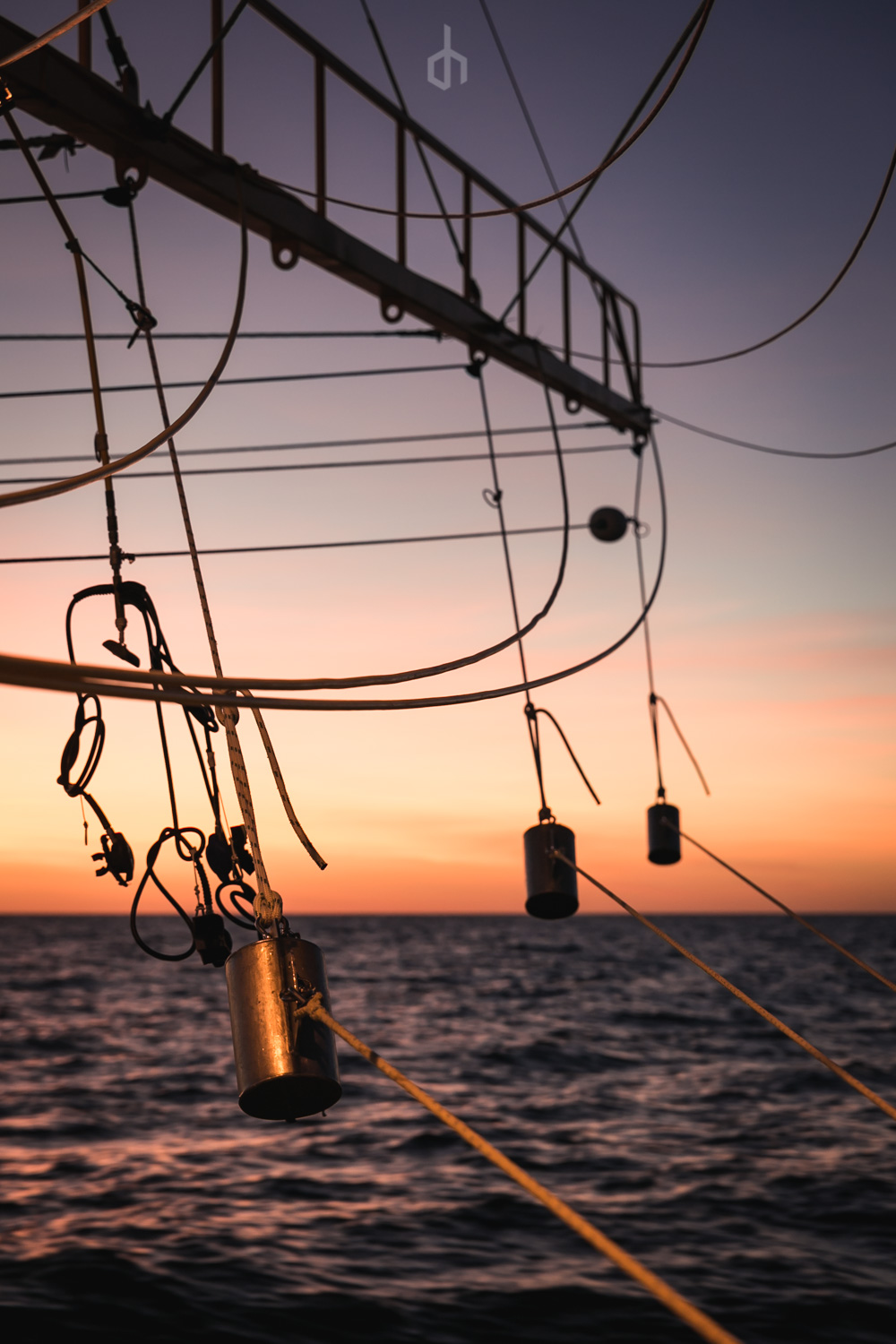
There is a boom out from each side of the ship from which the divers work. The Nalena Bay has four divers working from each boom. Heavy weights are attached to lines to take the divers to the bottom where they skim along just above the ocean floor. From the lines a rope is towed that the divers work off, looking for shell as the ship drifts slowly with the tide. Air is pumped down hoses from the ship to the divers masks. Every day at sea the men dive nine - fifty minute dives with only fifteen to twenty minutes in between spent cleaning shell and eating.
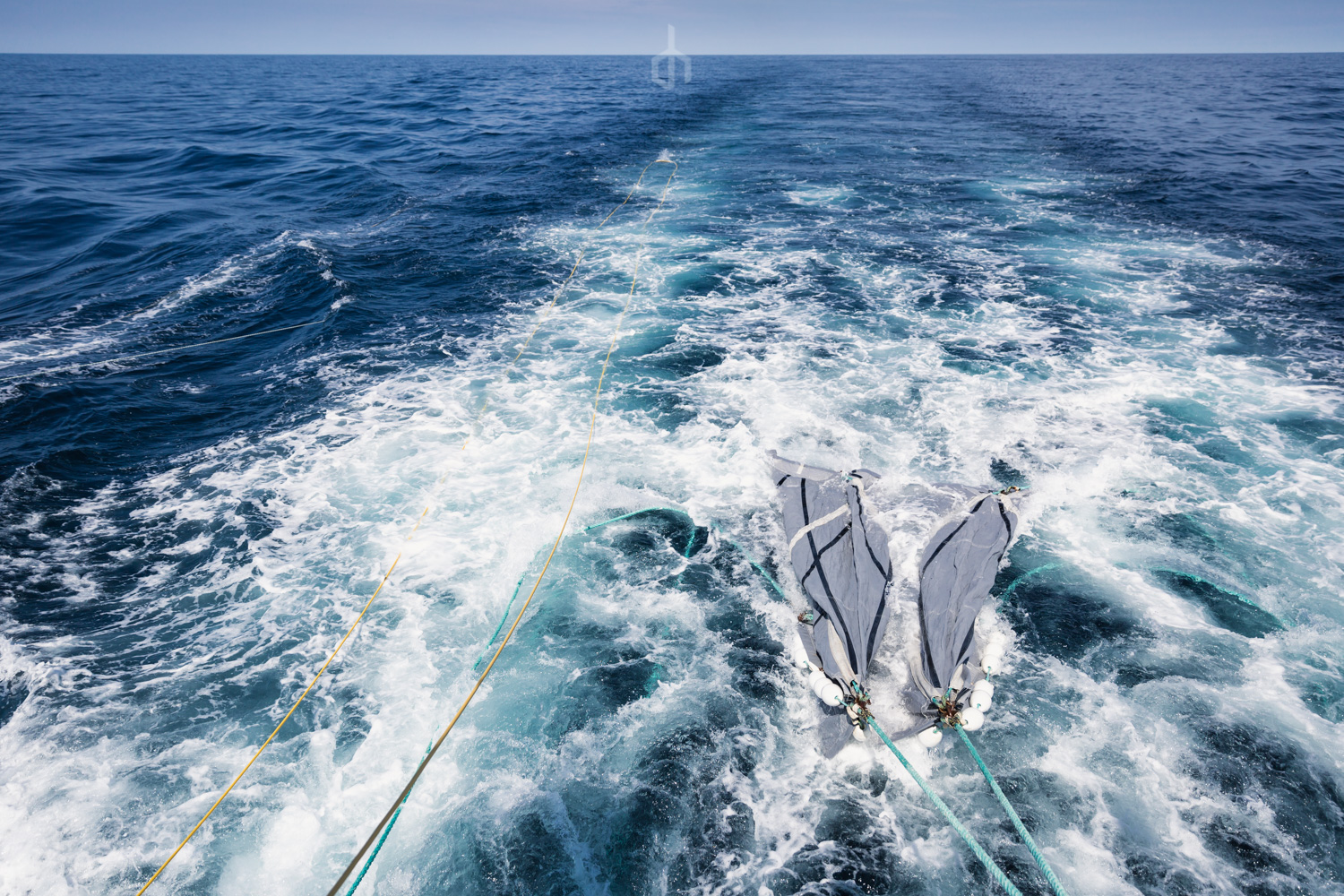
The drogue acts like a huge parachute underwater and catches the tide to slow the boat down so that it drifts at a speed that allows the divers ample time to scour their sections underwater.
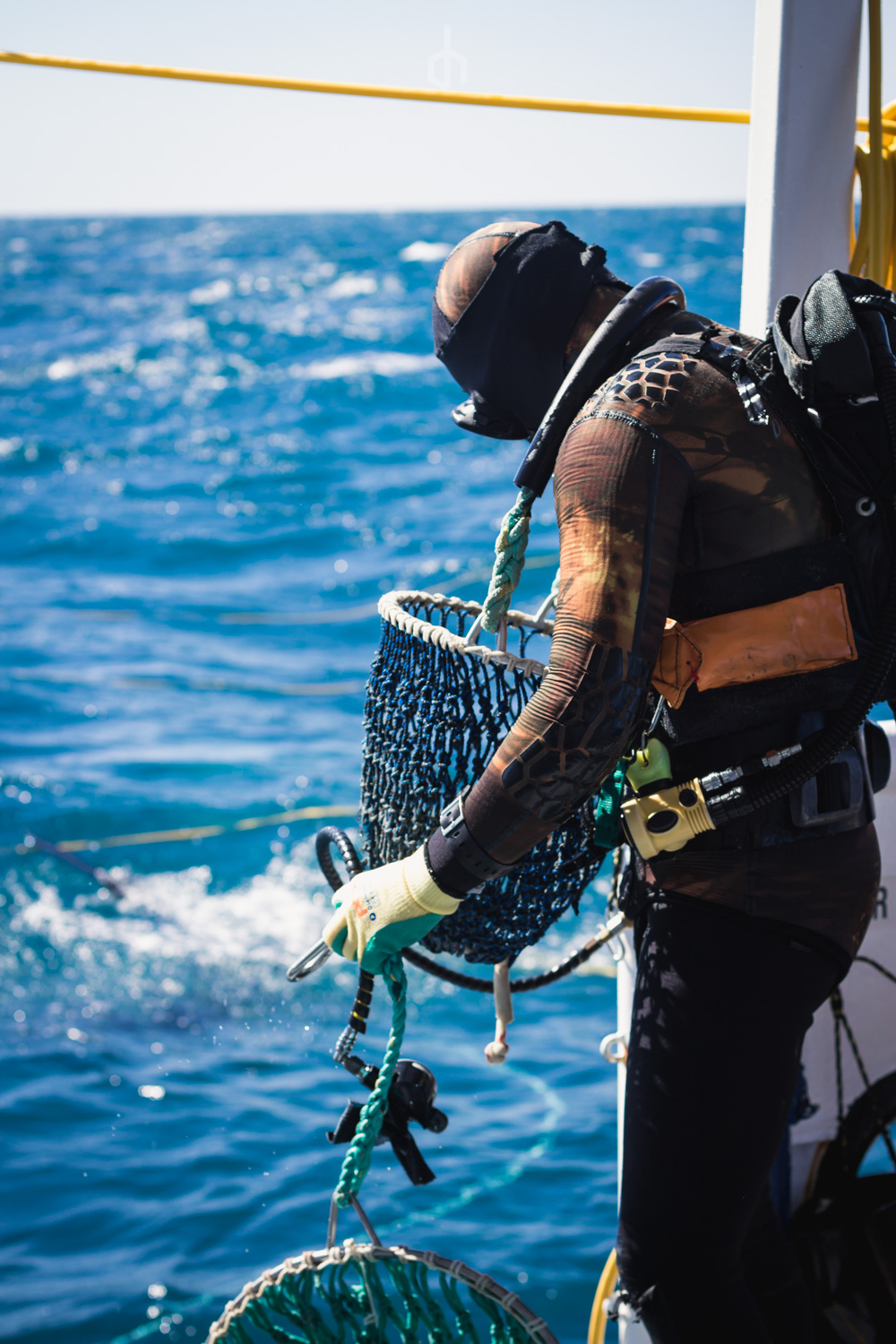
A diver in full kit is ready about to enter the water.
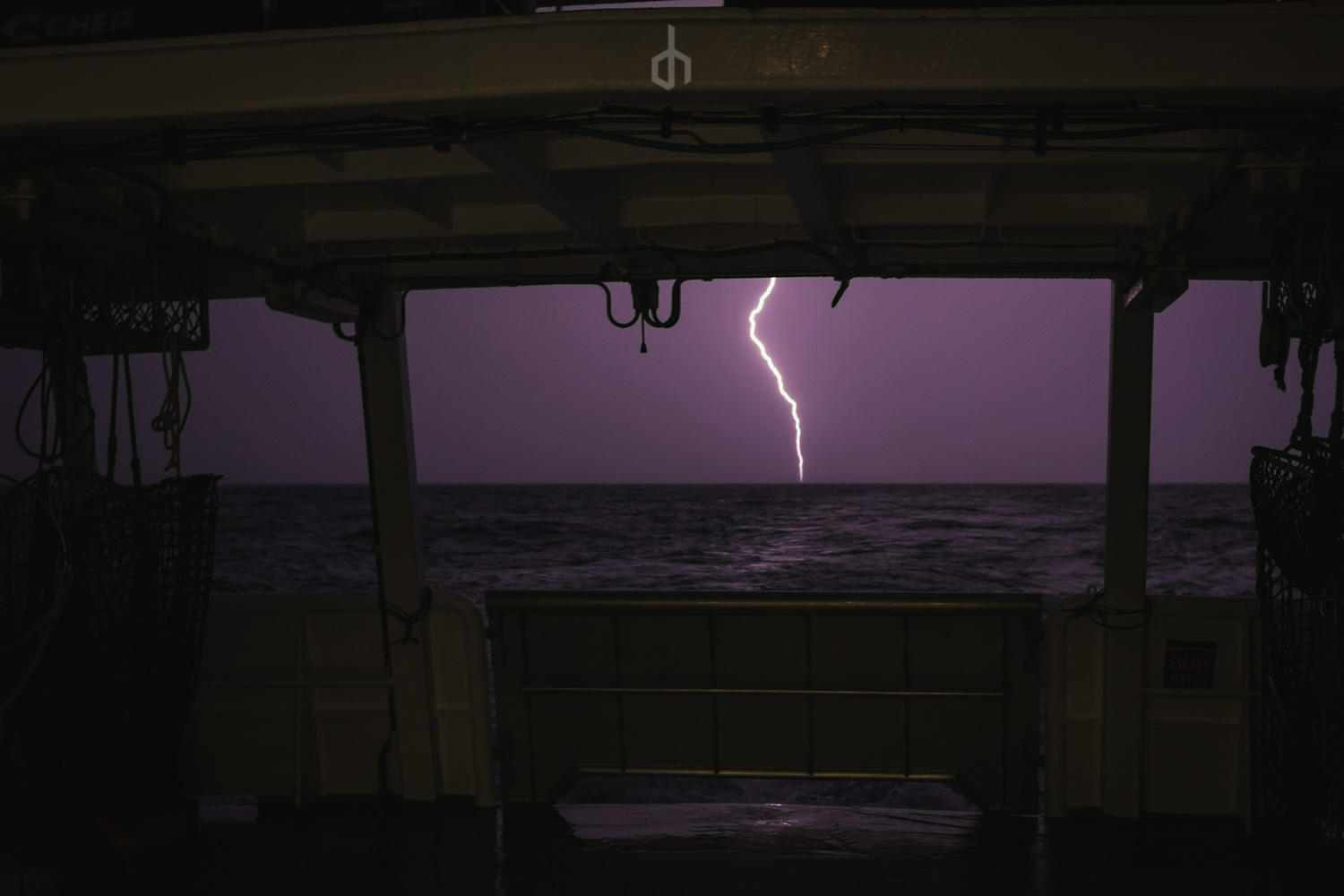
The voyage from Darwin to Broome is during the last few weeks of the wet season, where it rains periodically with heavy warm downpours often accompanied by electrical storms. On this occasion we were out to sea with lightening striking the ocean 360 degrees around the vessel. A spectacular display from nature.
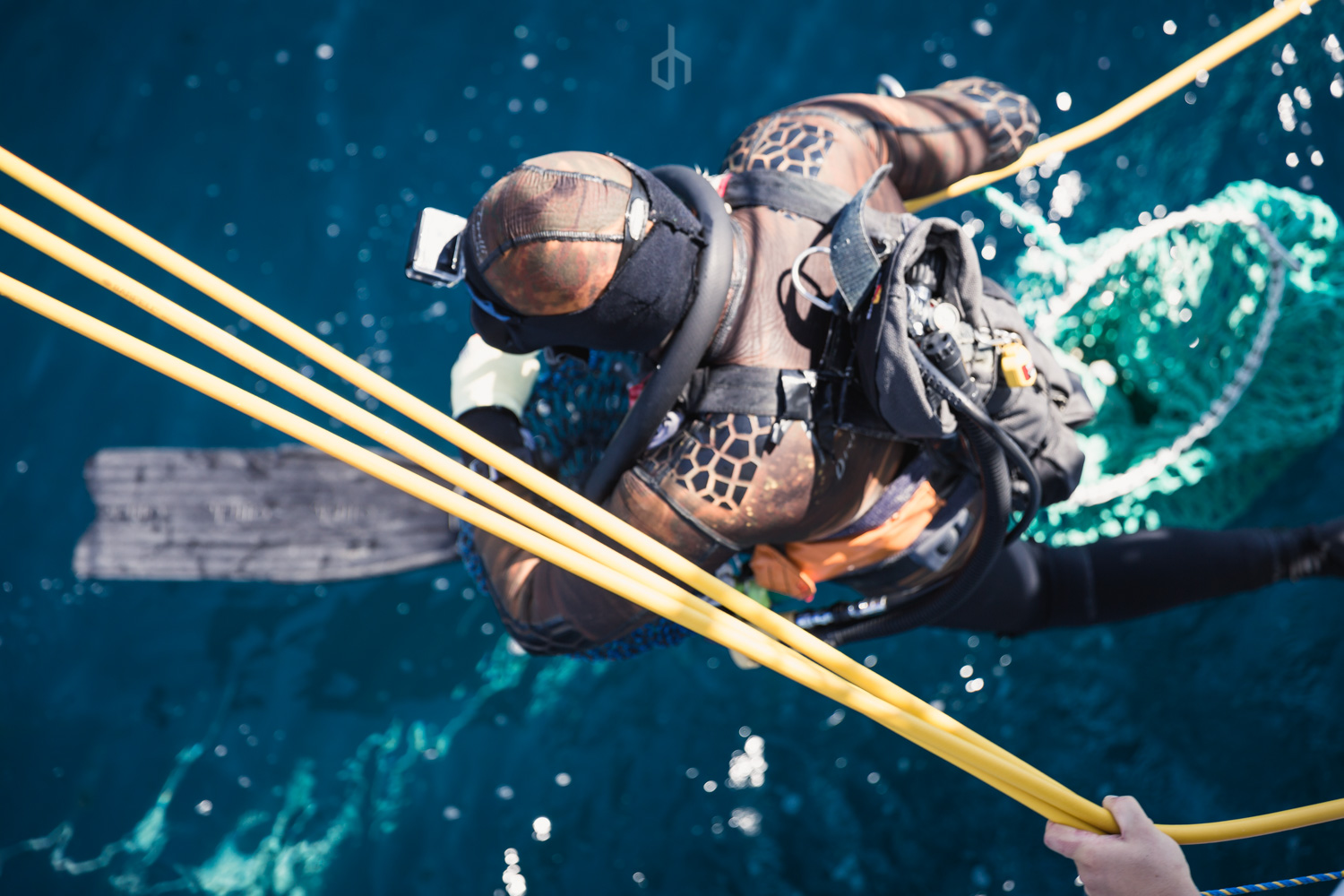
A diver enters the water to start his fifth dive of the day. Nine - fifty minute dives a day to depths of 20 metres is hugely taxing on the body and requires a huge amount of energy. The ships chef cooks a full spread of food which is ready after every second dive. The divers will finish cleaning shell and stand or sit on plastic chairs while they down their meals, still in wetsuits. As soon as they finish eating they are suiting up and heading back to the bottom.

The red tank on the back of the diver is the “Bail Out”. A tank of oxygen that has enough air to surface safely should there be a problem with the air hose. These are especially crucial in whale season when curious whales come to close and tear the divers hoses from their masks.
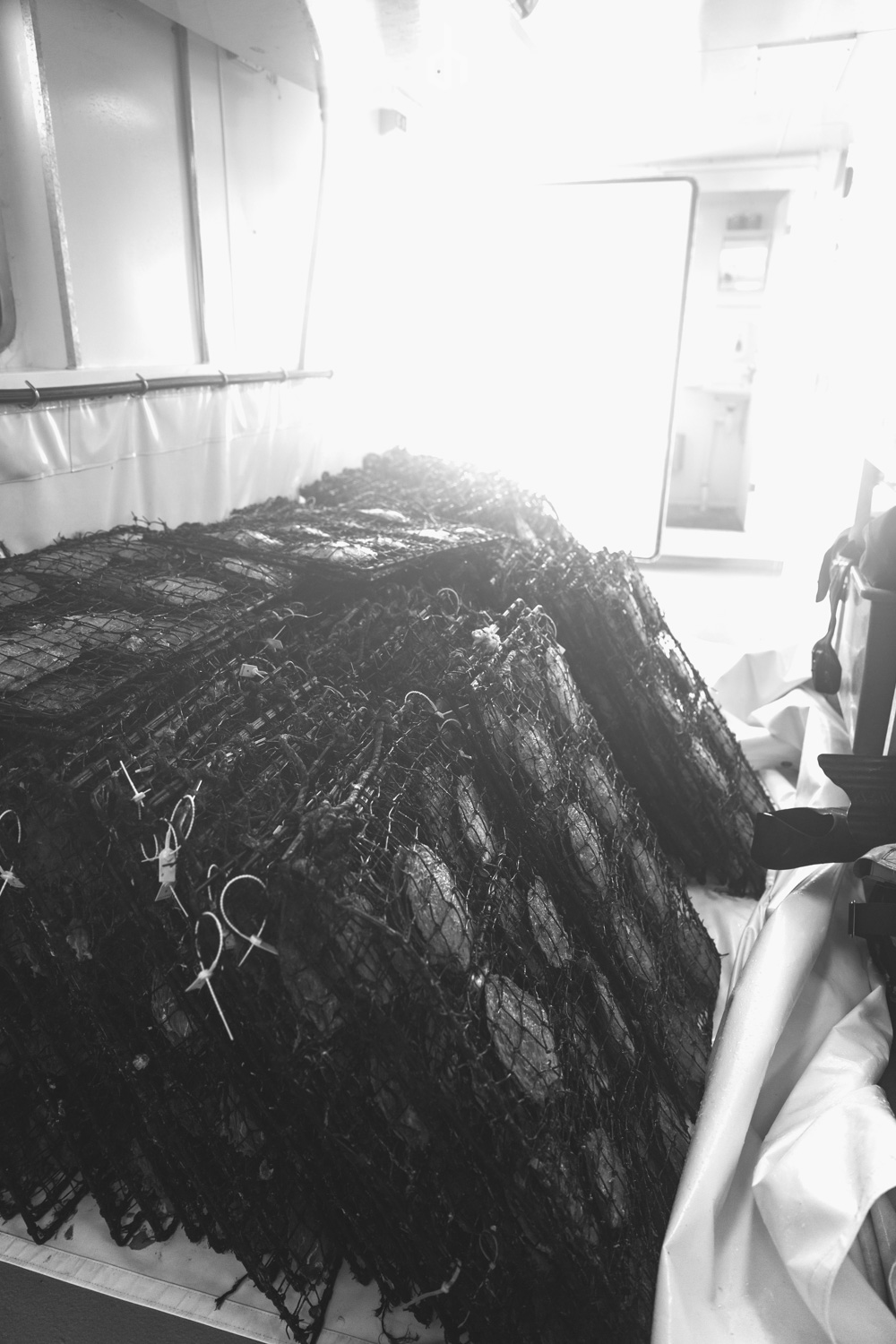
After being cleaned the shell are loaded into these panels which are then loaded on to the dump boat and sent out to be dropped on lines connected to buoys to sit just below the surface. At the end of the season the panels are collected and sent back to the farms set along the Kimberley Coast.
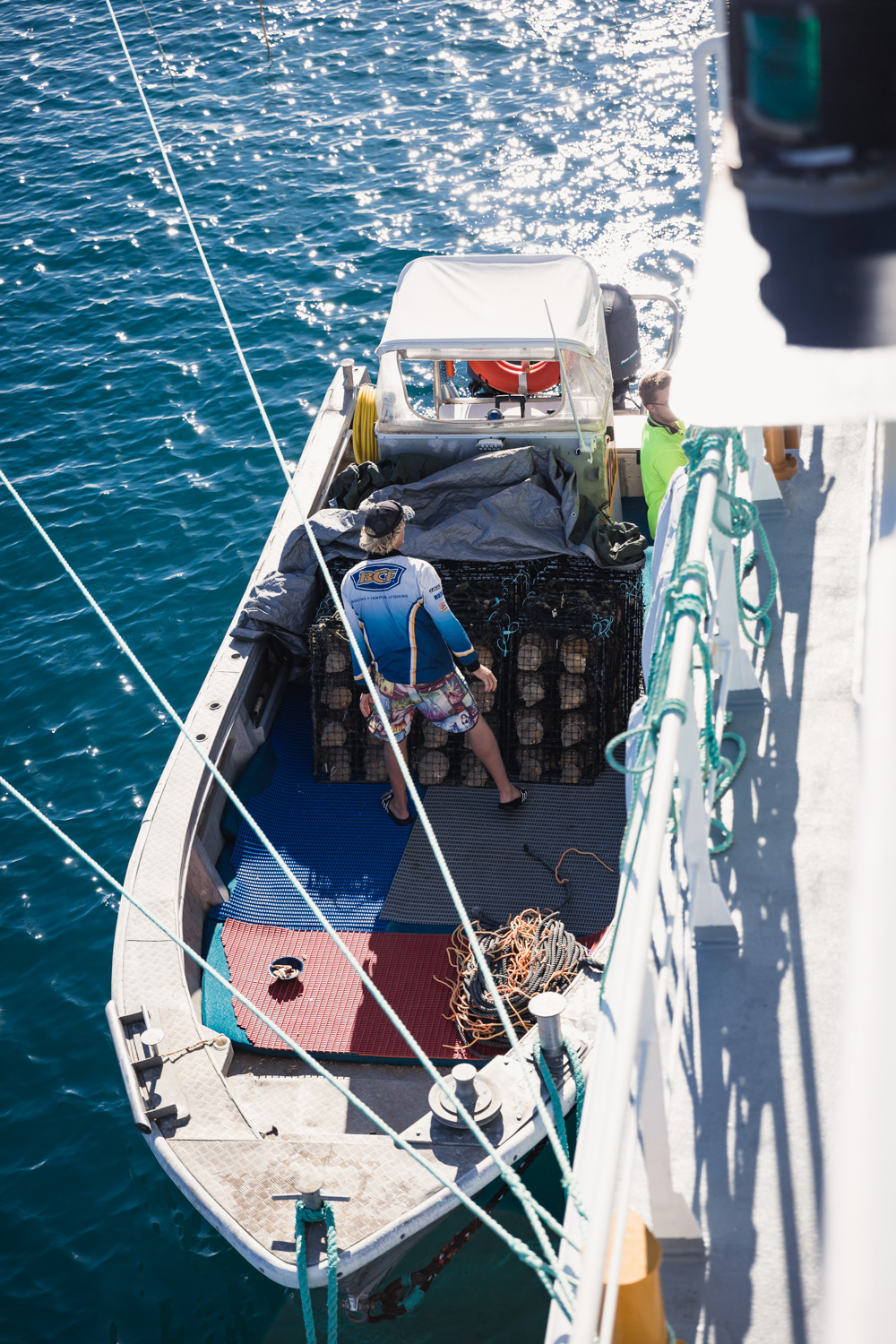
The dump boat is manned by two people, a diver and a skipper who are constantly shooting too and from the ship carrying shell out to drop on the lines. Loading the dump boat in rough seas is quite a challenge and quite dangerous as it jumps and lurches against the ship.
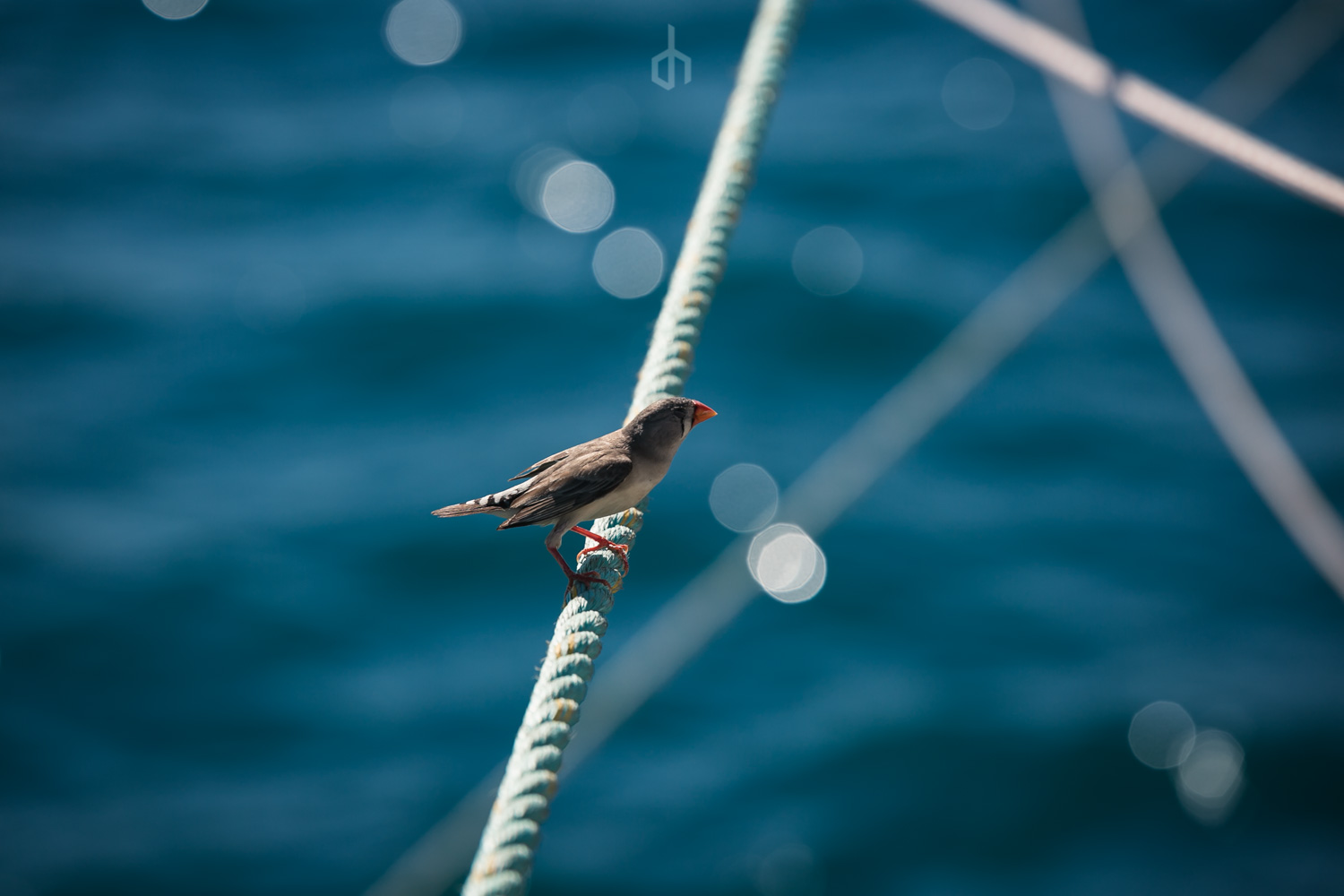
Hitchhikers are often land birds who have lost their way and come to rest on the ship like this Zebra Finch. Out to sea with no land in sight this bird stayed with us for a whole day to rest before flying on.
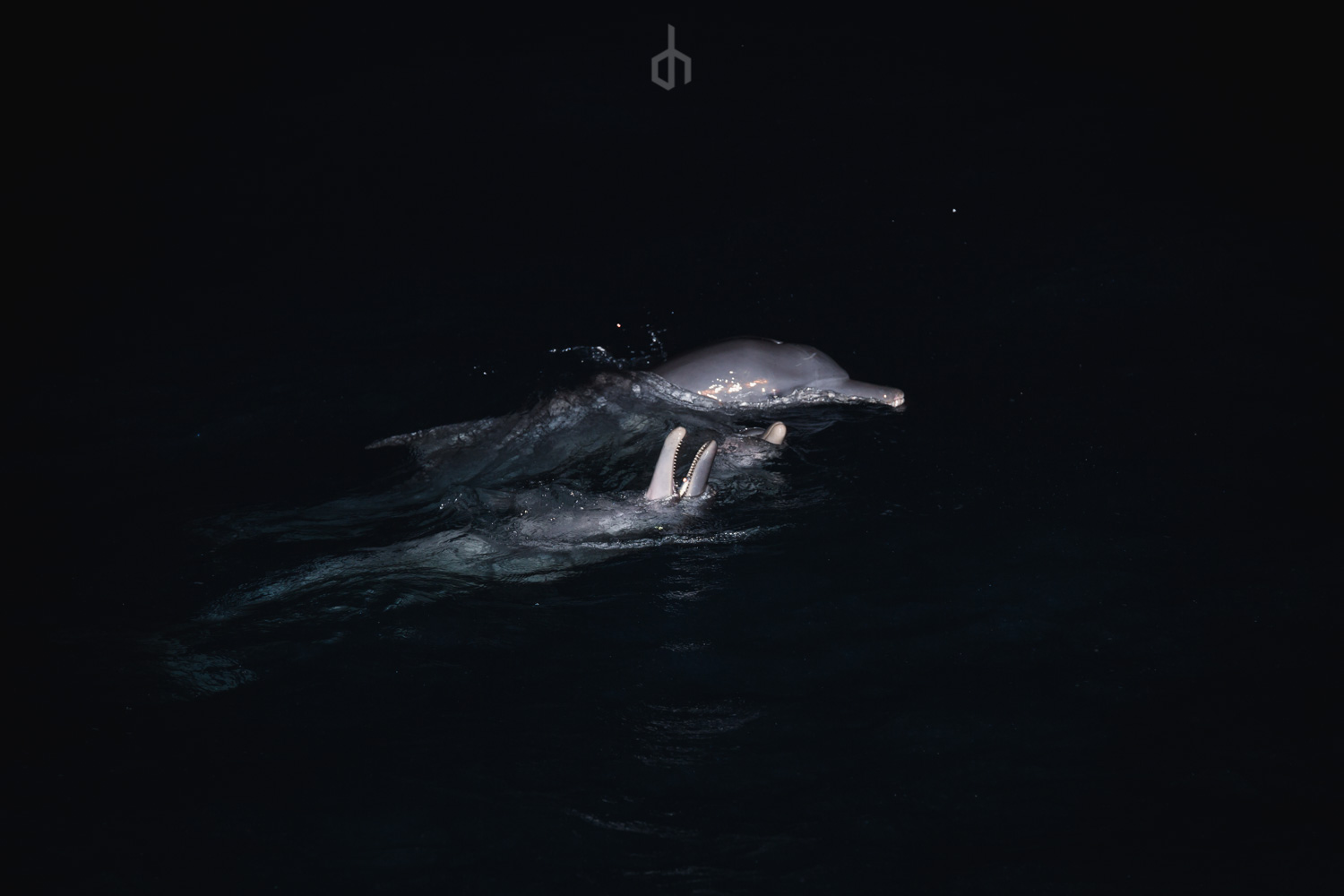
Some nights the massive flood lights are left on illuminating the area around the ship. This would attract all manor of sea life which would in turn brung huge pods of dolphins. Sometimes there would be hundreds of them chattering and playing around the ship. The divers often complained of them as their quarters were below deck and the dolphins made a huge amount of noise.
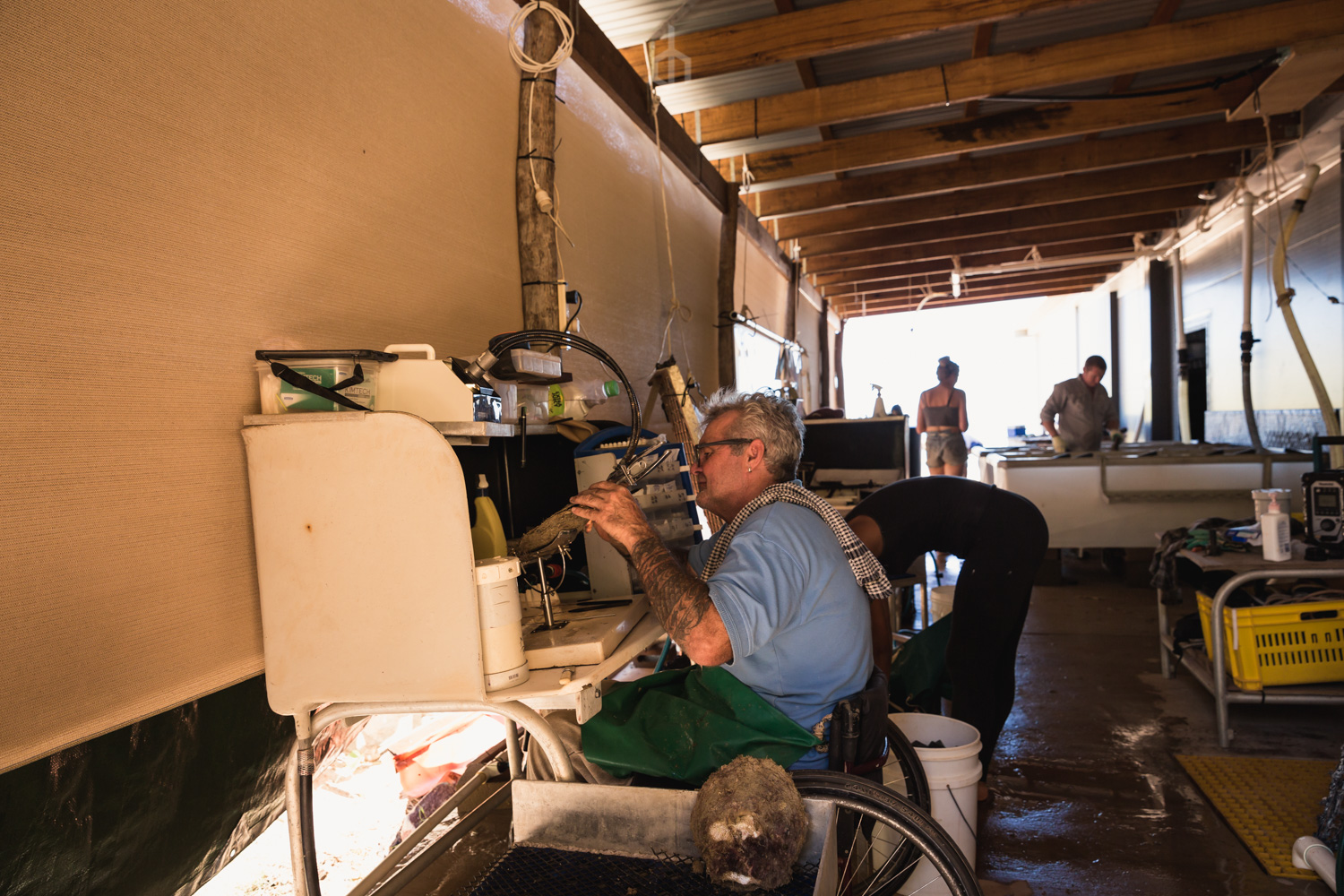
Back at the Pearl farm, technicians insert the nucleus into the shells that were found on the ocean floor. The Oysters are then taken out and dropped into the farm, again on panels to grow the cultured pearls.
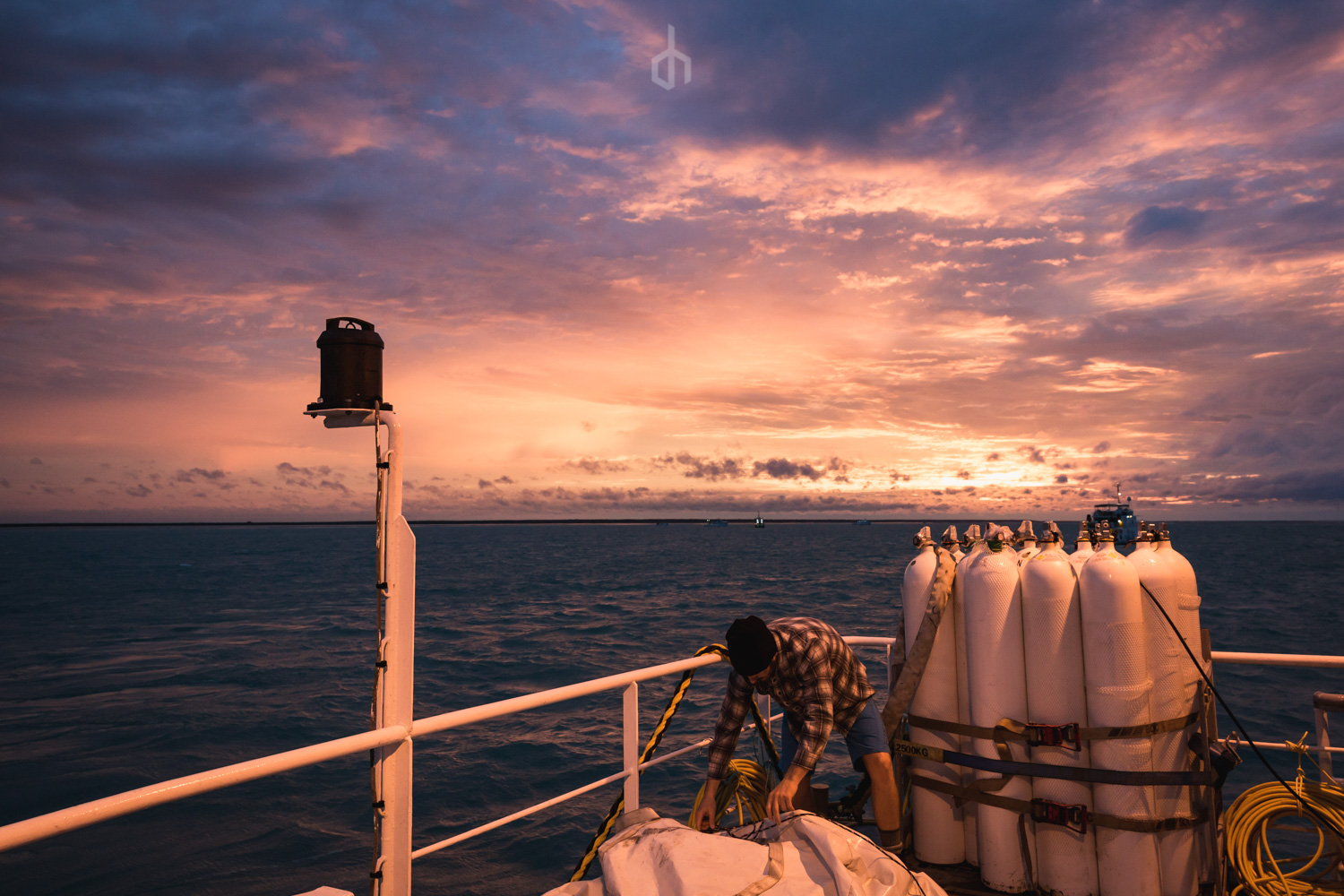
The skies are a never ending pleasure out at sea, sunset and sunrises better than any I have witnessed and on a clear night, stars that blanket they sky from horizon to horizon.

Pearl divers work incredibly hard and are subsequently paid quite well depending on the company worked for. There is a certain amount of risk attached and there has been fatal incidents in the past.
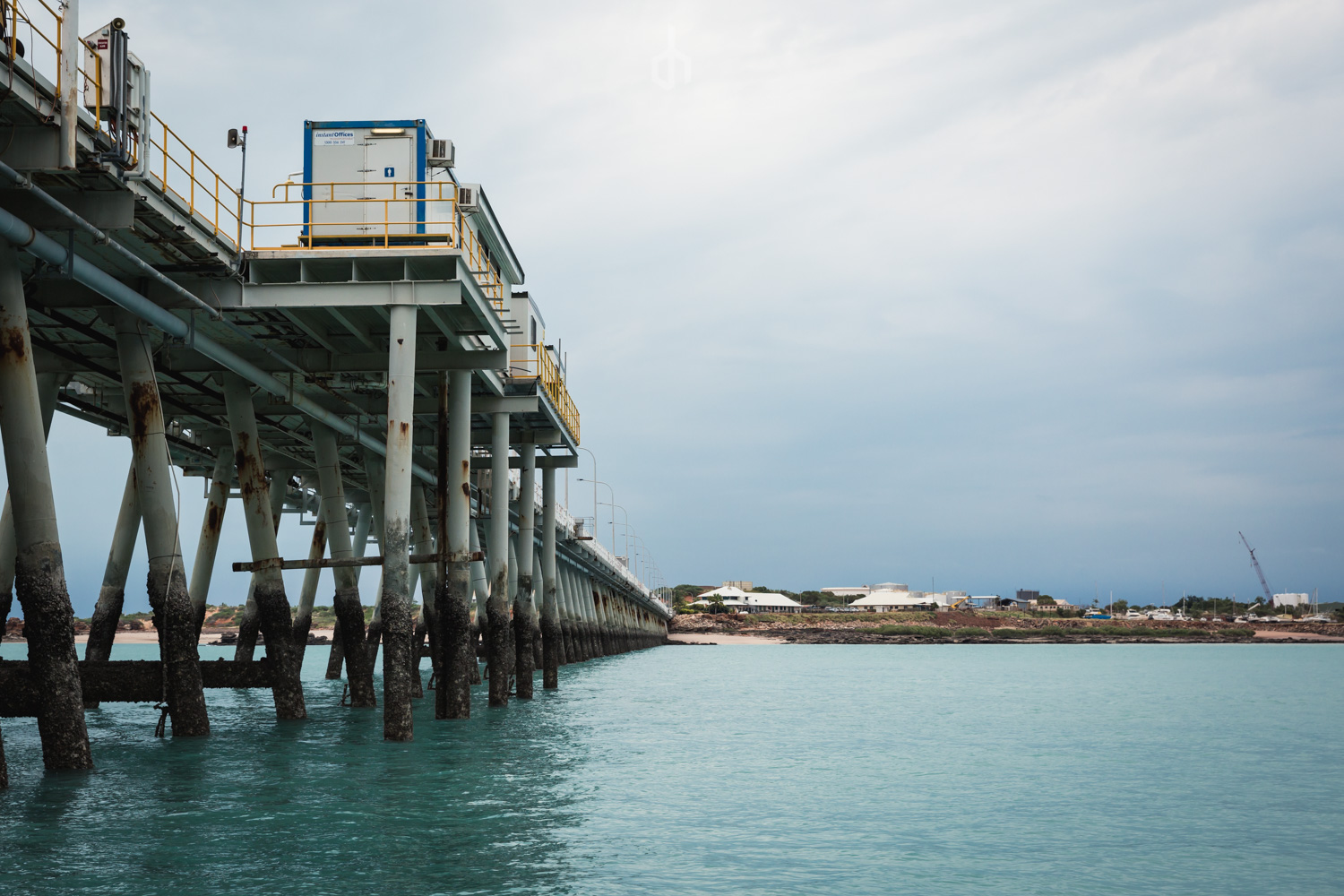
Roebuck Bay pier at low-tide. There is a variation of ten-twelve metres in the tides around Broome and the Kimberley region.
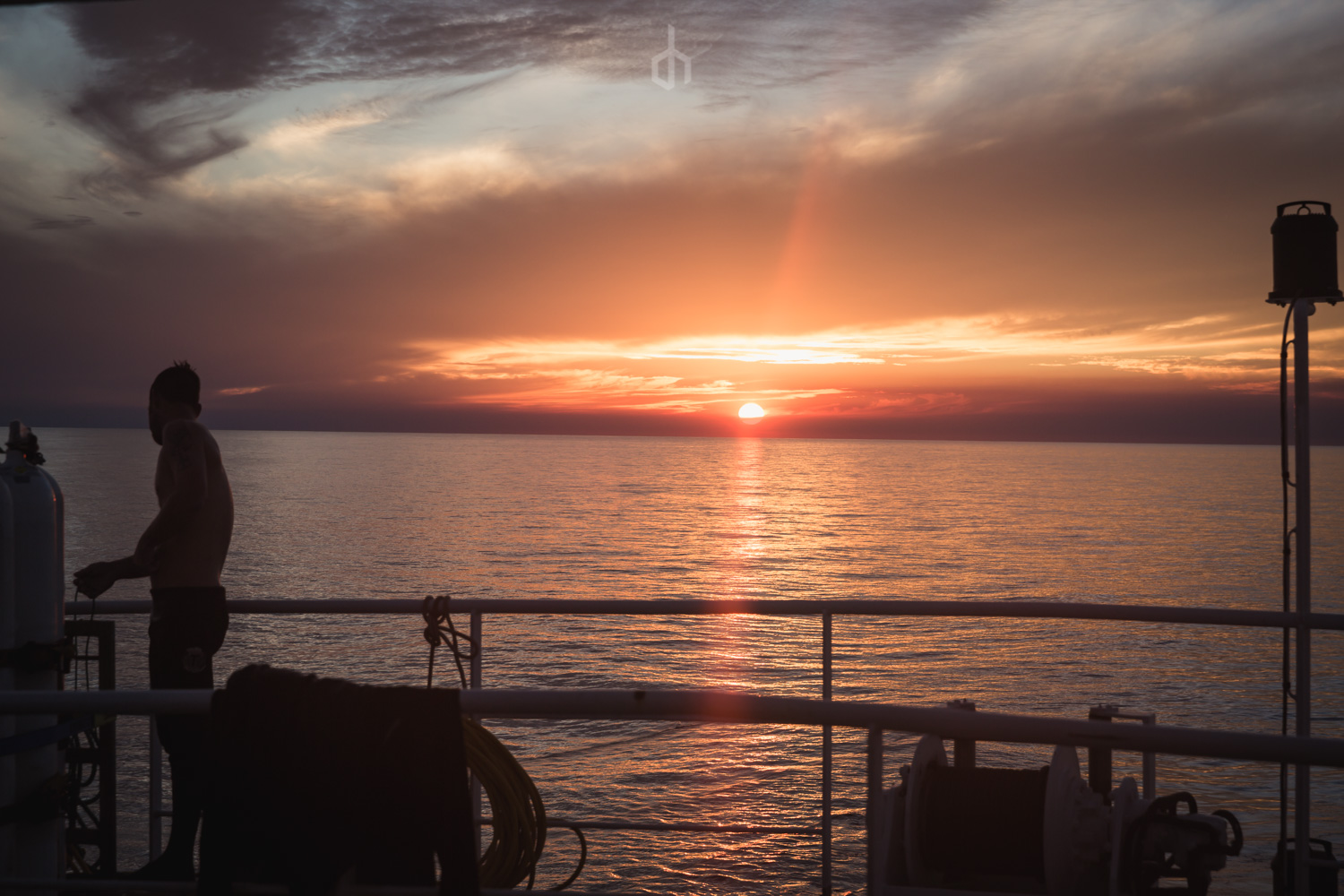






























Another faacet of the pearl operation is the meat which sells for an exuberant price on international markets and in considered a delicacy worldwide. Here a lab worker is points to the small slab of white pearl meat.
From Oyster to Pearl. The process of cultivating Pearls from Australian Pearl companies. Documented from time spent at sea on a working vessel and an active pearl farm.
The perks off working the dump boat. The divers often carry a spear gun incase they come across some fish suitable to feed the crew. Here is a massive Spanish Mackerel brought back for the chef to cook. Sashimi and Namus (or Civiche) are regular features on the menu.
A trio of ships from Paspaleys Pearling fleet leaving Darwin to sail to Broome, WA, to begin the pearl diving season.
Looking out of the kitchen porthole on one of those stunning WA mornings.
Steaming through the Buccaneers Archipelago down into the Kimberley, just a couple of weeks before the diving season is set to start.
Pearl diving vessels in Broome sail on the Neap tides and are back in port for the Springs. Roebuck Bay during the Spring tide has many White ships sitting on storm moorings while the crews take R&R. Once the Spring is up the crews head back and the ships take turns on the dock to resupply before heading back out to sea.
The red rocks and bright blue water of the east Kimberley coastline.
A rare species of dolphin native to Roebuck Bay would occasionally come and visit the ship.
During the voyage from Darwin to Broome we were treated to amazing skies. Taken from the Bridge of the Nalena Bay.
The Nalena Bay was at the time the newest edition to the Paspaley Pearls fleet. Inside she has three decks and 14 crew when set for drift diving. Her shape makes her comfortable even in the roughest seas, with little pitch she rolls easily over the waves.
The weather in the Kimberley during the dry season is almost always sunny and calm. Time spent steaming to and from operating areas is enjoyed by the crew.
The rear off the ship is where all the work takes place. The divers hang their nets and gear from hooks ready to earn their bounty from the ocean floor. The divers carry a small net around their necks and large one attached to a line. They fill the small net skimming the ocean floor and as that fills up empty it into the large net. At the end of the dive the large nets are pulled to the surface by the deck hands who then turn them out to be sorted on the cleaning table.
A ship is designated a certain patch of ocean where there is suspected to be a good level of shell on the floor which could be miles out to sea . Sometimes this requires steaming for a full day with the crew taking watch shifts to ensure the ship stays on course through the night.
Regularly we would be miles out to sea with no land in sight and birds would land on the ship to hitch a ride. Often they would stick around for a day to rest before moving on. The crew takes a fondness to these travellers.
There is a boom out from each side of the ship from which the divers work. The Nalena Bay has four divers working from each boom. Heavy weights are attached to lines to take the divers to the bottom where they skim along just above the ocean floor. From the lines a rope is towed that the divers work off, looking for shell as the ship drifts slowly with the tide. Air is pumped down hoses from the ship to the divers masks. Every day at sea the men dive nine - fifty minute dives with only fifteen to twenty minutes in between spent cleaning shell and eating.
The drogue acts like a huge parachute underwater and catches the tide to slow the boat down so that it drifts at a speed that allows the divers ample time to scour their sections underwater.
A diver in full kit is ready about to enter the water.
The voyage from Darwin to Broome is during the last few weeks of the wet season, where it rains periodically with heavy warm downpours often accompanied by electrical storms. On this occasion we were out to sea with lightening striking the ocean 360 degrees around the vessel. A spectacular display from nature.
A diver enters the water to start his fifth dive of the day. Nine - fifty minute dives a day to depths of 20 metres is hugely taxing on the body and requires a huge amount of energy. The ships chef cooks a full spread of food which is ready after every second dive. The divers will finish cleaning shell and stand or sit on plastic chairs while they down their meals, still in wetsuits. As soon as they finish eating they are suiting up and heading back to the bottom.
The red tank on the back of the diver is the “Bail Out”. A tank of oxygen that has enough air to surface safely should there be a problem with the air hose. These are especially crucial in whale season when curious whales come to close and tear the divers hoses from their masks.
After being cleaned the shell are loaded into these panels which are then loaded on to the dump boat and sent out to be dropped on lines connected to buoys to sit just below the surface. At the end of the season the panels are collected and sent back to the farms set along the Kimberley Coast.
The dump boat is manned by two people, a diver and a skipper who are constantly shooting too and from the ship carrying shell out to drop on the lines. Loading the dump boat in rough seas is quite a challenge and quite dangerous as it jumps and lurches against the ship.
Hitchhikers are often land birds who have lost their way and come to rest on the ship like this Zebra Finch. Out to sea with no land in sight this bird stayed with us for a whole day to rest before flying on.
Some nights the massive flood lights are left on illuminating the area around the ship. This would attract all manor of sea life which would in turn brung huge pods of dolphins. Sometimes there would be hundreds of them chattering and playing around the ship. The divers often complained of them as their quarters were below deck and the dolphins made a huge amount of noise.
Back at the Pearl farm, technicians insert the nucleus into the shells that were found on the ocean floor. The Oysters are then taken out and dropped into the farm, again on panels to grow the cultured pearls.
The skies are a never ending pleasure out at sea, sunset and sunrises better than any I have witnessed and on a clear night, stars that blanket they sky from horizon to horizon.
Pearl divers work incredibly hard and are subsequently paid quite well depending on the company worked for. There is a certain amount of risk attached and there has been fatal incidents in the past.
Roebuck Bay pier at low-tide. There is a variation of ten-twelve metres in the tides around Broome and the Kimberley region.
